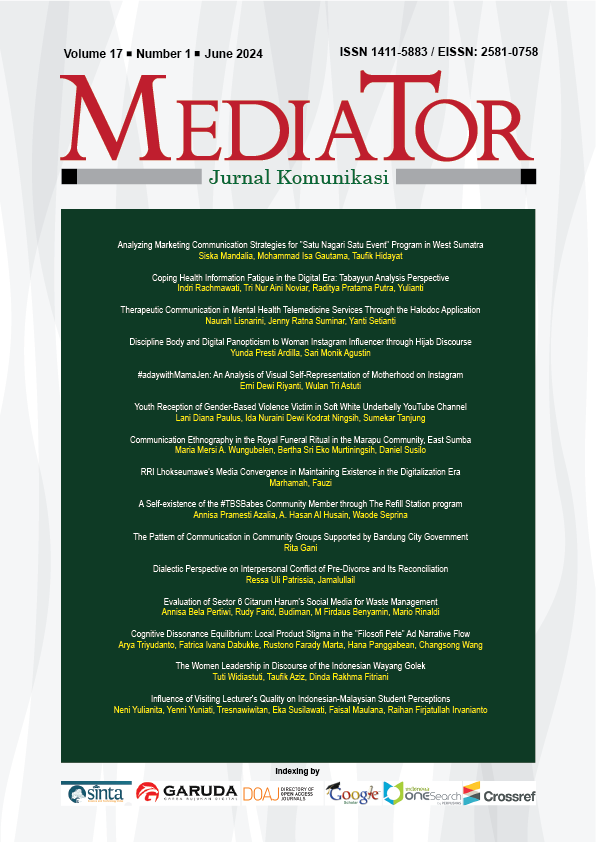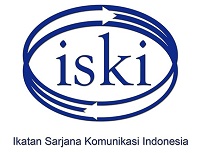The Women Leadership in Discourse of the Indonesian Wayang Golek
DOI:
https://doi.org/10.29313/mediator.v17i1.3171Keywords:
Cultural studies, feminism, hermeneutics, wayang golek (rod puppet), women leadershipAbstract
Puppets are not only entertainment but also reflect philosophical values. Arimbi Ngadeg Ratu, an Indonesian rod puppet, is full of wise advice, moral teachings, and philosophical phrases about politics and power. In emphasizing gender and leadership, women occupy roles defined in their specific positions within the hierarchy and simultaneously function within the constraints of their gender roles. This study uses the Gadamer hermeneutic for interpretation; the method is based on experience, history, and tradition from a cultural feminism perspective. Research findings show the role and position of women as mothers who nurture and educate their children to be good leaders. Women have complementary roles and positions in their families, but they must be able to be independent. Women also have the right to assemble, rehearse, lead an organization, and have the freedom to make their own choices. Women also have the same abilities as men to become political leaders and have equal opportunities to compete for power. Leadership roles for women are achieved by fighting in the realm of patriarchal norms. Reframing the image of women's political leadership from a gender viewpoint that considers keeping values and principles an operation of feminism seems proper.
References
Aaldering, L., & Pas, D. J. Vander. (2020). Political Leadership in the Media: Gender Bias in leader stereotypes during campaign and routine times. British Journal of Political Science, 50(3), 911–931. https://doi.org/10.1017/S0007123417000795.
Arvate, P. R., Galilea, G. W., & Todescat, I. (2018). The queen bee: A myth? The effect of top-level female leadership on subordinate females. Leadership Quarterly, 29(5), 533–548. https://doi.org/10.1016/j.leaqua.2018.03.002.
Aspinall, E., White, S., & Savirani, A. (2021). Women’s Political Representation in Indonesia: Who Wins and How? Journal of Current Southeast Asian Affairs, 40(1), 3–27. https://doi.org/10.1177/1868103421989720.
Bankert, A. (2020). Let’s Talk About Sexism: The Differential Effects of Gender Discrimination on Liberal and Conservative Women’s Political Engagement. American Politics Research, 48(6), 779–791. https://doi.org/10.1177/1532673X20939503.
Bayo, L. N. (2021). Women Who Persist: Pathways to Power in Eastern Indonesia. Journal of Current Southeast Asian Affairs, 40(1), 93–115. https://doi.org/10.1177/1868103421989712.
Begeny, C. T., Ryan, M. K., Moss-Racusin, C. A., & Ravetz, G. (2020). In some professions, women have become well represented, yet gender bias persists—Perpetuated by those who think it is not happening. Science Advances, 6(26), 1–11. https://doi.org/10.1126/sciadv.aba7814.
El Adawiyah, S., Hubeis, A. V., Sumarti, T., & Susanto, D. (2020). Political Communication of Indonesian Female Regional Leaders. Jurnal ASPIKOM, 5(2), 365. https://doi.org/10.24329/aspikom.v5i2.655.
Epperson, M., Gouveia, C. J., Tabangin, M. E., Takiar, V., Howell, R., Altaye, M., Ishman, S. L., & Tang, A. L. (2020). Female Representation in Otolaryngology Leadership Roles. Laryngoscope, 130(7), 1664–1669. https://doi.org/10.1002/lary.28308.
Fajrussalam, H., & Hasanah, A. (2018). Core Ethical Values of Character Education Based on Sundanese Culture Value. IJECA (International Journal of Education and Curriculum Application), 1(3), 15. https://doi.org/10.31764/ijeca.v1i3.2126.
Gillo, M. D. (2021). Fundamentals of Hermeneutics as A Qualitative Research Theoretical Framework. European Journal of Education and Pedagogy, 2(3), 42–45. https://doi.org/10.24018/ejedu.2021.2.3.43.
Ifadhah, N., & Irwansyah, I. (2022). Parenting Education and Communication of Gender Equality Persuasion in the Family on @Latihati. Mediator: Jurnal Komunikasi, 14(2), 240. https://doi.org/10.29313/mediator.v14i2.8124.
Liu, S.-J. S. (2019). Cracking Gender Stereotypes? Challenges Women Political Leaders Face. Political Insight, 10(1), 12–15. https://doi.org/10.1177/2041905819838147.
Maheshwari, G. (2023). A review of literature on women’s leadership in higher education in developed countries and in Vietnam: Barriers and enablers. Educational Management Administration and Leadership, 51(5), 1067–1086. https://doi.org/10.1177/17411432211021418.
Maseda, A., Iturralde, T., Cooper, S., & Aparicio, G. (2022). Mapping women’s involvement in family firms: A review based on bibliographic coupling analysis. International Journal of Management Reviews, 24(2), 279–305. https://doi.org/10.1111/ijmr.12278.
Nurlimah, N., Hirzi, A. T., Kamila, L., & Fitriastuti, N. (2020). Dedi Mulyadi Political Branding in Identifying Sundanese Purwakarta Characters. Mediator: Jurnal Komunikasi, 13(1), 39–48. https://doi.org/10.29313/mediator.v13i1.5347.
Oskooii, K. A. R. (2020). Perceived discrimination and political behavior. British Journal of Political Science, 50(3), 867–892. https://doi.org/10.1017/S0007123418000133.
Pascua, M., Kushner, T., & Woodward, Z. (2019). Promoting Leadership by Women in Gastroenterology—Lessons Learned and Future Directions. Gastroenterology, 156(6), 1548–1552. https://doi.org/10.1053/j.gastro.2019.03.012.
Perdana, A., & Hillman, B. (2020). Quotas and ballots: The impact of positive action policies on women’s representation in Indonesia. Asia and the Pacific Policy Studies, 7(2), 158–170. https://doi.org/10.1002/app5.299.
Pierli, G., Murmura, F., & Palazzi, F. (2022). Women and Leadership: How Do Women Leaders Contribute to Companies’ Sustainable Choices? Frontiers in Sustainability, 3(July), 1–10. https://doi.org/10.3389/frsus.2022.930116.
Prakoso, B. (2020). Reviewing Gadamer’s Hermeneutics in Communication Studies. Mediator: Jurnal Komunikasi, 13(2), 307–318. https://doi.org/10.29313/mediator.v13i2.5981.
Prihatini, E. S. (2019). Women who win in Indonesia: The impact of age, experience, and list position. Women’s Studies International Forum, 72(August 2018), 40–46. https://doi.org/10.1016/j.wsif.2018.10.003.
Prihatini, E. S. (2020). Islam, Parties, and Women’s Political Nomination in Indonesia. Politics and Gender, 16(3), 637–659. https://doi.org/10.1017/S1743923X19000321.
Roper, R. L. (2019). Does Gender Bias Still Affect Women in Science? Microbiology and Molecular Biology Reviews, 83(3), 1–9. https://doi.org/10.1128/mmbr.00018-19.
Sauky, M. A., & Bukhori, B. (2021). Makna Sosial dalam Nilai-nilai Budaya Sunda pada Lakon Wayang Golek Ki Dalang Wisnu Sunarya. TEMALI : Jurnal Pembangunan Sosial, 4(2), 155–167. https://doi.org/10.15575/jt.v4i2.12722.
Setzler, M. (2018). Measuring Bias against Female Political Leadership. Politics and Gender, 15(4), 695–721. https://doi.org/10.1017/S1743923X18000430.
Smith, C. A., McLure, F., Kuzich, S., Ferns, S., & Murphy, S. (2024). Empowering Second+ Career Female Academics: Strengthening Relationships through Mentoring for Personal and Professional Growth. Advancing Women in Leadership Journal, 43, 1–14. https://doi.org/10.21423/awlj-v43.a416.
Sobari, W. (2016). Politically equal but still underrepresented: Women and local democratic politics in Indonesia. International Journal of Asia-Pacific Studies, 12(1), 61–92.
Srivastava, N., & Nalawade, R. (2023). Glass Ceiling To Sticky Floor: Analogies of Women Leadership. International Journal of Professional Business Review, 8(4), 1–18. https://doi.org/10.26668/businessreview/2023.v8i4.1300.
Takyar, D. (2019). When Interest Doesn’t Turn into Action: Discrimination, Group Identification, and Muslim Political Engagement in the Post-9/11 Era. Social Psychology Quarterly, 82(3), 231–253. https://doi.org/10.1177/0190272519853542.
White, S., & Aspinall, E. (2019). Why does a Good Woman Lose? Barriers to Women’ s Political Representation in Indonesia. 1–13. https://www.ipu.org/.
Yuliawati, S., & Ekawati, D. (2023). Sketching women: A corpus analysis of woman representation in the Sundanese Magazine Manglé (1958–2019). Indonesian Journal of Applied Linguistics, 13(1), 176–185. https://doi.org/10.17509/ijal.v13i1.58282.
Downloads
Published
Issue
Section
License
Copyright (c) 2024 Tuti Widiastuti; Taufik Aziz, Dinda Rakhma Fitriani

This work is licensed under a Creative Commons Attribution-ShareAlike 4.0 International License.























